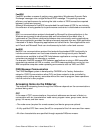
Klinkmann Automation Omron Ethernet DAServer 3
Omron Ethernet DAServer Ver 1.x User Manual Rev 1.3 17014m13
Microsoft Windows program capable of acting as a DDE, SuiteLink ™ or OPC client that
can also coexist with FactorySuite ™ 2000 and greater.
Communication Protocols
The OMRON Ethernet Direct DAServer communicates with clients and PLCs using the
following different communications protocols:
• Application communications protocols such as OPC, DDE and SuiteLink to
communicate with clients located on either local or remote nodes.
• FINS message communications protocol to communicate with the Omron controllers
over FA (Factory Automation) networks.
Important! This DAServer is compliant with the OPC Data Access (DA) 2.05
specification.
For more information about the DAServer architecture, see the Reference section.
Application Communications Protocols
The DAServer utilizes the following application communications protocols to
communicate with the clients.
OPC
OPC (OLE for Process Control) is a non-proprietary set of standard interfaces based
upon Microsoft’s OLE/COM technology. This standard makes possible interoperability
between automation/control applications, field systems/devices and business/office
applications.
Avoiding the traditional requirement of software/application developers to write custom
drivers to exchange data with field devices, OPC defines a common, high-performance
interface that permits this work to be done once, and then easily reused by HMI, SCADA,
control and custom applications. Over the network, OPC uses DCOM (Distributed COM)
for remote communications.
SuiteLink
SuiteLink uses a TCP/IP-based protocol and is designed specifically to meet industrial
needs such as data integrity, high throughput, and easier diagnostics. This TCP/IP
standard is supported on Windows NT and Windows NT-technology-based operating
systems (for example, Windows NT, Windows 2000, and Windows XP).
SuiteLink is not a replacement for DDE, FastDDE, or NetDDE. The protocol used
between a client and a server depends on your network connections and configurations.
SuiteLink provides the following features:
• Value Time Quality (VTQ) places a time stamp and quality indicator on all data values
delivered to VTQ-aware clients.
• Extensive diagnostics of the data throughput, server loading, computer resource
consumption, and network transport are made accessible through the operating system’s
performance monitor. This feature is critical for the operation and maintenance of
distributed industrial networks.
• Consistent high data volumes can be maintained between applications regardless if the
applications are on a single node or distributed over a large node count.
• The network transport protocol is TCP/IP using Microsoft’s standard WinSock interface.


















